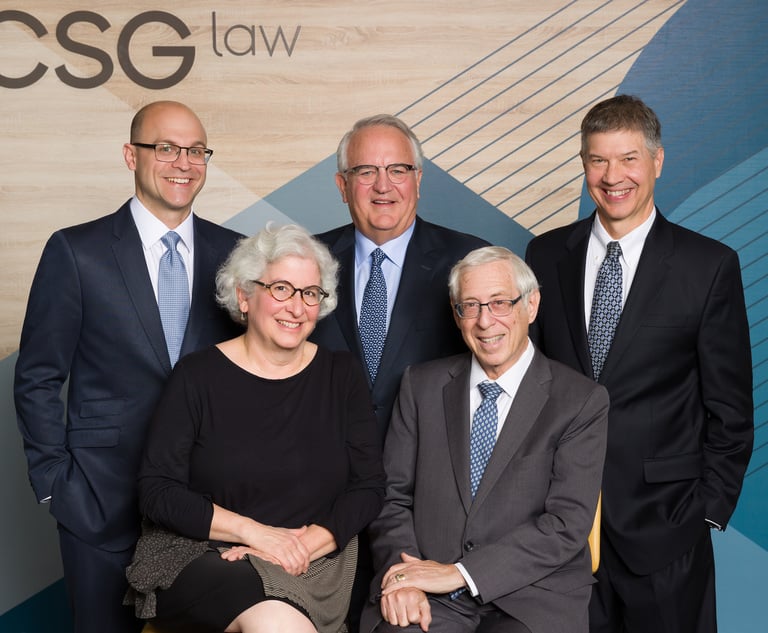Aegis No More: Disarming Residential Developers Through Corporate Veil Piercing
Corporate veil piercing removes the possibility of a large developer allowing a defunct entity to absorb a judgment without payment.
October 26, 2018 at 11:00 AM
8 minute read

We can all recall law school lectures on the panoply of business forms available to entities seeking to incorporate. This foundational decision impacts how the entity will be governed and, ultimately, how its liabilities will be allocated. Somewhere along the way, however, the salutary purpose of permitting businesses to incorporate as they see fit devolved into complex corporate labyrinths erected by organizations to escape liability for their own misconduct.
In theory, corporate subsidiaries and affiliates are separate and distinct. When these entities run as free-standing, self-governed organizations manned by their own employees that operate as a going concern such that the entities have a separate existence from their corporate parent, the law respects the corporate form. However, when corporations create a pyramid of empty shells to shield the only viable entity from the consequences of their own misconduct, the law provides a very powerful, albeit cautiously invoked remedy: corporate veil piercing.
In the real estate development area, this is how business is done. In some situations, nominal development entities are created years after due diligence on a parcel has been conducted; preliminary engineering studies performed; and in some cases, even after acquisition.
Some of these sites suffer from serious engineering issues that render development impossible without the risk of serious construction defects or, at the very least, render development economically unattractive. But the allure of profit in a competitive sector is seductive. And, developers ignore these admonitions and build anyway. Not only do they build; they cut corners along the way to engineer their way to fatter margins.
The inevitable result is a gilded community that loses its luster shortly after closing. Scores of families are saddled with pervasive construction deficiencies that may manifest years after developers have absconded with their profits, and perilously close to statutes of repose that threaten to extinguish potential claims forever.
Even where a prospective plaintiff can fund and mount a successful construction defect lawsuit, the prospect of an uncollectable paper judgment entered against an assetless entity clouds any hope of recovery.
That is why the prospect of corporate veil piercing is so important. It removes the possibility of a large developer allowing a defunct entity to absorb a judgment without payment despite the public relations backlash it may cause.
In the case of publicly traded developers, it also establishes upstream liability—implicating SEC reporting requirements, credit ratings and other business considerations. Thus, when business morality no longer incentivizes builders to do right by purchasers, veil piercing becomes a righteous tool.
So, what is veil piercing and how does it work in practice?
Our Supreme Court has stated that a corporate subsidiary's veil may be pierced “on a finding that the parent so dominated the subsidiary that it had no separate existence but was merely a conduit for the parent [,]” and that the piercing is necessary to avoid an injustice. State, Dep't of Envtl. Prot. v. Ventron Corp., 94 N.J. 473, 501 (1983).
Domination is the sine qua non of veil piercing. To determine domination, courts have been guided by several factors: (i) whether the subsidiary was grossly undercapitalized; (ii) the day-to-day involvement of the parent's directors; (iii) the day-to-day involvement of officers and personnel; (iv) whether the subsidiary fails to observe corporate formalities; (v) pays no dividends; (vi) is insolvent; (vii) lacks corporate records; or (vii) is merely a facade. Verni ex rel. Burstein v. Harry M. Stevens, 387 N.J. Super. 160, 200 (App. Div. 2006).
In other words, “the hallmarks of that abuse are typically the engagement of the subsidiary in no independent business of its own but exclusively the performance of a service for the parent and, even more importantly, the undercapitalization of the subsidiary rendering it judgment-proof.” OTR Associates v. IBC Servs., 353 N.J. Super. 48, 52 (App. Div. 2002); see also Pharmacia Corp. v. Motor Carrier Servs. Corp., 309 F. App'x 666, 673 (3d Cir. 2009) (affirming district court's piercing the corporate veil) (holding that Intermodal used Motor Carrier solely to hold the Kearny Site for its business (without payment), to shield itself from any potential liability arising out the environmental harms caused by Pharmacia's former operations); 701 Penhorn Ave. Associates v. J. Fanok Holdings, 2013 WL 709125, at *2 (App. Div. Feb. 28, 2013) (affirming veil piercing where LLC created for the sole purpose of managing the leases, parent paid all the rent and CAM charges, LLC was un-capitalized, had no assets or employees and engaged in no separate business to insulate itself from liability, and thus was organized for an unjust purpose, that constituted “an abuse of the corporate structure.”).
While the taxonomy and layers of corporate hierarchies vary by residential developer, the strategy is commonly effected in three steps: (1) create thinly capitalized nominal development entities at the bottom of the corporate hierarchy to assume all legal liabilities for a proposed residential development project; (2) siphon all value from the development entity and transfer it upstream to the apex parent holding company or a separate subsidiary to render the nominal development entity judgment-proof; and (3) erect a complex web of paper shell entities between the nominal developer and apex parent company to frustrate would-be claimants from recovery.
In OTR Assocs. v. IBC Servs., 353 N.J. Super. 48 (App. Div. 2002), Judge Pressler recognized the fundamental unfairness created by this precise abuse of the corporate form. Here, (a) Blimpie formed IBC for the sole purpose of holding the lease on the premises of a Blimpie franchisee; (b) IBC had virtually no assets other than the lease itself, which, was subject to Blimpie's exclusive control; (c) it had no business premises of its own, sharing the New York address of Blimpie; (d) it had no income other than the rent payments by the franchisee; and (e) it did not have its own employees or office staff. Id. at 52-53.
The Appellate Division noted, “[i]t hardly required a cryptographer to draw the entirely reasonable inference that IBC stood for International Blimpie Corporation, Blimpie's corporate name when the lease was executed. The suggestion, unmistakably, was that IBC was either the corporate name or a trading-as name and that International Blimpie Corporation was the other of these two possibilities.” Id. at 54. Judge Pressler artfully admonished what she termed “mechanistically impeccable” corporate structuring and explained that the corporate form was “not intended to shield the parent from responsibility for its subsidiary's obligations but rather to shield the parent from its own obligations. And that is an evasion and an improper purpose, fraudulently conceived and executed.” Id. at 56 (emphasis added).
As illustrated by IBC Servs., veil piercing is a powerful remedy. And, when invoked, it can be used to attack entities that are the real beneficiaries of a corporate scheme, entities that may not even have a direct ownership interest in the nominal developer.
As our Appellate Division stated in Brown-Hill Morgan v. Lehrer, 2010 WL 3184340, at *11 (App. Div. Aug. 12, 2010), the defendant therein “was entitled to structure the transaction in a manner to maximize his own return, but he cannot, in a court of equity, be permitted to walk away from the reality of the transaction. '[E]quity [regards] substance [,] rather than form.'” Id. at *11 (internal citations omitted).
Thus, the law will look to the economic and practical reality of an economic transaction to hold the real beneficiaries liable for any damages caused by their conduct.
Although the defense bar has argued that the passage of the Revised Uniform Limited Liability Company Act (RULLCA), N.J.S.A. 42:2C-1, et seq., displaced the traditional veil piercing analysis with respect to limited liability companies, that is simply not so. RULLCA specifically acknowledges circumstances under which members or managers may be liable for the “debts, obligations, or other liabilities of the company,” and thus, only confirms the enduring applicability of veil piercing to limited liability companies.
RULLCA simply clarifies that the failure to observe corporate formalities—i.e., the misuse of stationary—without more, cannot be the basis for liability. The traditional Ventron factors—domination and the perpetration of injustice—remain the polestar of veil piercing jurisprudence in the corporate and limited liability company contexts.
Over the past few years, recent Superior Court decisions have confirmed that the corporate shield proudly touted by residential developers has been significantly eroded.
Today, construction defect litigants are not only armed with remedial statutes like the New Jersey Consumer Fraud Act, N.J.S.A. 56:8-1, et seq., to hold developers responsible for their pervasive construction defects and misrepresentations and omissions in offering documents. Plaintiffs may also concurrently prosecute veil piercing claims against the apex development entities to hold apex parent entities responsible for their “own obligations” when their moral compass and conscience will not.
Vincenzo M. Mogavero is a shareholder at Becker & Poliakoff in Morristown, and chair of the firm's New Jersey and New York litigation groups.
This content has been archived. It is available through our partners, LexisNexis® and Bloomberg Law.
To view this content, please continue to their sites.
Not a Lexis Subscriber?
Subscribe Now
Not a Bloomberg Law Subscriber?
Subscribe Now
NOT FOR REPRINT
© 2024 ALM Global, LLC, All Rights Reserved. Request academic re-use from www.copyright.com. All other uses, submit a request to [email protected]. For more information visit Asset & Logo Licensing.
You Might Like
View All
Appellate Div. Follows Fed Reasoning on Recusal for Legislator-Turned-Judge
4 minute read
Chiesa Shahinian Bolsters Corporate Practice With 5 From Newark Boutique
5 minute read
'A Mockery' of Deposition Rules: Walgreens Wins Sanctions Dispute Over Corporate Witness Allegedly Unfamiliar With Company
Trending Stories
- 1Friday Newspaper
- 2Judge Denies Sean Combs Third Bail Bid, Citing Community Safety
- 3Republican FTC Commissioner: 'The Time for Rulemaking by the Biden-Harris FTC Is Over'
- 4NY Appellate Panel Cites Student's Disciplinary History While Sending Negligence Claim Against School District to Trial
- 5A Meta DIG and Its Nvidia Implications
Who Got The Work
Michael G. Bongiorno, Andrew Scott Dulberg and Elizabeth E. Driscoll from Wilmer Cutler Pickering Hale and Dorr have stepped in to represent Symbotic Inc., an A.I.-enabled technology platform that focuses on increasing supply chain efficiency, and other defendants in a pending shareholder derivative lawsuit. The case, filed Oct. 2 in Massachusetts District Court by the Brown Law Firm on behalf of Stephen Austen, accuses certain officers and directors of misleading investors in regard to Symbotic's potential for margin growth by failing to disclose that the company was not equipped to timely deploy its systems or manage expenses through project delays. The case, assigned to U.S. District Judge Nathaniel M. Gorton, is 1:24-cv-12522, Austen v. Cohen et al.
Who Got The Work
Edmund Polubinski and Marie Killmond of Davis Polk & Wardwell have entered appearances for data platform software development company MongoDB and other defendants in a pending shareholder derivative lawsuit. The action, filed Oct. 7 in New York Southern District Court by the Brown Law Firm, accuses the company's directors and/or officers of falsely expressing confidence in the company’s restructuring of its sales incentive plan and downplaying the severity of decreases in its upfront commitments. The case is 1:24-cv-07594, Roy v. Ittycheria et al.
Who Got The Work
Amy O. Bruchs and Kurt F. Ellison of Michael Best & Friedrich have entered appearances for Epic Systems Corp. in a pending employment discrimination lawsuit. The suit was filed Sept. 7 in Wisconsin Western District Court by Levine Eisberner LLC and Siri & Glimstad on behalf of a project manager who claims that he was wrongfully terminated after applying for a religious exemption to the defendant's COVID-19 vaccine mandate. The case, assigned to U.S. Magistrate Judge Anita Marie Boor, is 3:24-cv-00630, Secker, Nathan v. Epic Systems Corporation.
Who Got The Work
David X. Sullivan, Thomas J. Finn and Gregory A. Hall from McCarter & English have entered appearances for Sunrun Installation Services in a pending civil rights lawsuit. The complaint was filed Sept. 4 in Connecticut District Court by attorney Robert M. Berke on behalf of former employee George Edward Steins, who was arrested and charged with employing an unregistered home improvement salesperson. The complaint alleges that had Sunrun informed the Connecticut Department of Consumer Protection that the plaintiff's employment had ended in 2017 and that he no longer held Sunrun's home improvement contractor license, he would not have been hit with charges, which were dismissed in May 2024. The case, assigned to U.S. District Judge Jeffrey A. Meyer, is 3:24-cv-01423, Steins v. Sunrun, Inc. et al.
Who Got The Work
Greenberg Traurig shareholder Joshua L. Raskin has entered an appearance for boohoo.com UK Ltd. in a pending patent infringement lawsuit. The suit, filed Sept. 3 in Texas Eastern District Court by Rozier Hardt McDonough on behalf of Alto Dynamics, asserts five patents related to an online shopping platform. The case, assigned to U.S. District Judge Rodney Gilstrap, is 2:24-cv-00719, Alto Dynamics, LLC v. boohoo.com UK Limited.
Featured Firms
Law Offices of Gary Martin Hays & Associates, P.C.
(470) 294-1674
Law Offices of Mark E. Salomone
(857) 444-6468
Smith & Hassler
(713) 739-1250







